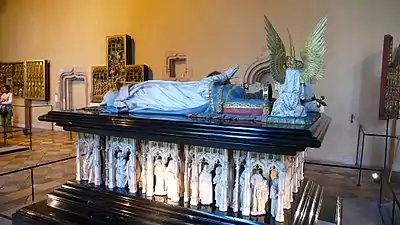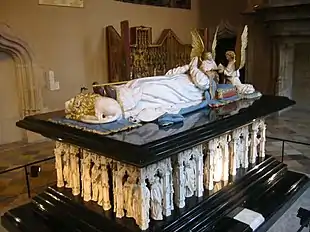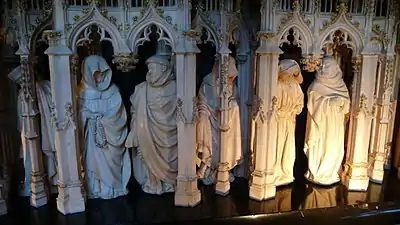Tomb of Philip the Bold
The Tomb of Philip the Bold is a funerary monument commissioned in 1384 by the Duke of Burgundy Philip the Bold (d. 1404) for his burial at the Chartreuse de Champmol, a Carthusian monastery on the outskirts of Dijon, in today's France. The monument's outline was probably built by Jean de Marville and Claus de Werve, and completed by Claus Sluter.[1][2] De Malouel was the official painter to the duke, and was the first sculptor commissioned for the tomb'.[1][3]

Today, it is housed in the Musée des Beaux-Arts de Dijon. The tomb art developed by De Marville and Sluter became widely influential in the following decades and greatly improved the artist's prestige.[4] Jean, Duke of Berry commissioned a similar work for his burial,[5] and it inspired the well known Mourners of Dijon, which were crafted a generation later.
Background and commission
_Mus%C3%A9e_des_Beaux-Arts_-_Tombeau_de_Philippe_II_de_Bourgogne_dit_le_Hardi_-_10.jpg.webp)
Philip acquired the domain of Champmol, near Dijon, in 1378 to build the Carthusian monastery Chartreuse de Champmol,[4] which he intended to house the tombs of his dynasty. He commissioned Jean de Marville in 1381 to "make an alabaster sepulcher for him in Dijon."[6] De Marville began the project in 1834, when employed artisans to cut and shape the alabaster for the arcades. The following he organised the arrival of one large, and several smaller blocks of black Dinant marble.[6]
Philip the Bold died in 1404, and his wife Margaret III, Countess of Flanders the following year. She had decided to rest her remains with those of her parents in Lille, and Philip had been planning a single monument for himself for over twenty years, having commissioned Jean de Marville in 1381. Work did not begin until 1384, and proceeded slowly, with Claus Sluter being put in charge in 1389. At the Duke's death in 1404, only two mourners and the framework were complete; John the Fearless gave Sluter four years to finish the job, but he died after two. His nephew and assistant, Claus de Werve took over and finished the sculptures in 1410. The effigies were painted by Malouel.[7]
Claus Sluter and Phillip van Eram were employed in 1439 to polish the work, while van Eram's main contribution was in adding to outlines of the capitals above the mourners, while Sluter designed the mourners themselves, the cherubs above them, and the detail in the arches of the niches. By then the work seems to have been under Sluter's ownership since 1397, and the preparatory work was brought to Champmol, in Paris, where the final masonry work began.[6] In 1402 the tomb had become so large that Sluter was forced to break through the wall around the designated area.[8]
The tomb was not finished in time for Philip's death in 1404; while the structure and arcades were in place, the effigies and mourners were yet to be carved. His son, John the Fearless, was known as a ruthless and unscrupulous politician, and assumed control of the project.[8] Philip was ultimately buried in the choir, on 16 June 1404, although his organs were sent to the church of Saint Martin at Halle. In 1792, his body was re-interred at Dijon Cathedral.[9] The following year the tomb was damaged by revolutionaries and looters. It was restored in the first half of the 19th century.[10]
Description
Slab

The monument is made from alabaster, marble, gilt and paint.[11] The upper reliefs contains Philip's sarcophagus effigy. He is depicted in repose, with his eyes open and his hands upright and clasped in prayer. An angel with gilded wings holds a cushion, formed from black marble slab, for his head. A lion rests at his feet while below him are 41 pleurants standing in pairs in Gothic niches, arranged as if mourners at a procession.[10] The extensive inscriptions below the slab record his identity, position, and date of death: "VERY NOBLE AND POWERFUL PRINCE AND FOUNDER OF THIS CHURCH...WHO PASSED AWAY AT HALLE IN BRABANT ON THE XXVIITH DAY OF APRIL, YEAR OF OUR LORD ONE THOUSAND FOUR HUNDRED AND FOUR".[12]
The silver plate with painted bright red overtones helmet was probably designed by de Werve and finished by Sluter.[13]
Mourners

_Mus%C3%A9e_des_Beaux-Arts_-_Tombeau_de_Philippe_II_de_Bourgogne_dit_le_Hardi_-_08.jpg.webp)
The pleurants are by far the most interesting aspect of the tomb, and are regarded as among Claus Sluter's finest reliefs.[14] A total of 40 mourners are shown in mourning below the arcade, each measuring between 39 to 42 cm in height.[14] They are led by a priest holding the aspergillum, two choirboys, an acolyte, a deacon and bishop, three cantors and two Carthusian monks. Behind these clerics are members of Philip's family and close members of his court. Although each mourner is given an individualised face, not can be considered as portraits.[12]
Sluter and Phillip van Eram were employed in 1439 to polish and finish the work. van Eram's main contribution was in adding to outlines of the capitals above the mourners, while Sluter designed the mourners themselves, the cherubs above them, and the detail in the arches of the niches.[6]
See also
References
- Foss (2008), 172
- Sadler (2005), 46
- Morand, Kathleen. "'Les Pleurants dans l'Art du Moyen Age en Europe' at Dijon". Burlington Magazine, volume 113, No. 823, 1971. 620-624. JSTOR 876777
- Sadler (2005), 47
- Woods (2007), 132
- Jugie (2010), 38
- Jugie, Sophie. "Les Ducs de Bourgogne". Musées de Bourgogne, 2003. Retrieved 5 September. 13-14
- Jugie (2010), 39
- Moffitt, John. "Sluter's "Pleurants" and Timanthes' "Tristitia Velata": Evolution of, and Sources for a Humanist Topos of Mourning". Artibus et Historiae, Volume 26, No. 51, 2005, pp. 73-84 JSTOR 1483776
- Jugie, 121
- Nicholas, Napoli. The Ethics of Ornament in Early Modern Naples. Routledge, 215.
- Jugie (2010), 37
- Jugie (2010), 42
- Jugie (2010), 47
Sources
| Wikimedia Commons has media related to Tomb of Philip the Bold. |
- Jugie, Sophie. The Mourners: Tomb Sculpture from the Court of Burgundy . Paris: 1; First Edition, 2010. ISBN 978-0-3001-5517-4
- Foss, Gloria. Romanesque & Gothic. London: Sterling, 2008. ISBN 978-1-4027-5924-6
- Reeves, Matthew. "A Reconsideration of the Tomb of Jean de Berry for the Sainte-Chapelle at Bourges, its Inception, Revision and Reconstruction". Medieval History, Medieval Studies.
- Sadler, Donna. Stone, Flesh, Spirit: The Entombment of Christ in Late Medieval Burgundy. Brill, 2015. ISBN 978-9-0042-9314-4
- Woods, Kim (ed). Making Renaissance Art. Yale University Press, 2007. ISBN 978-0-3001-2189-6
_03.jpg.webp)
_04.jpg.webp)
_07.jpg.webp)
_08.JPG.webp)